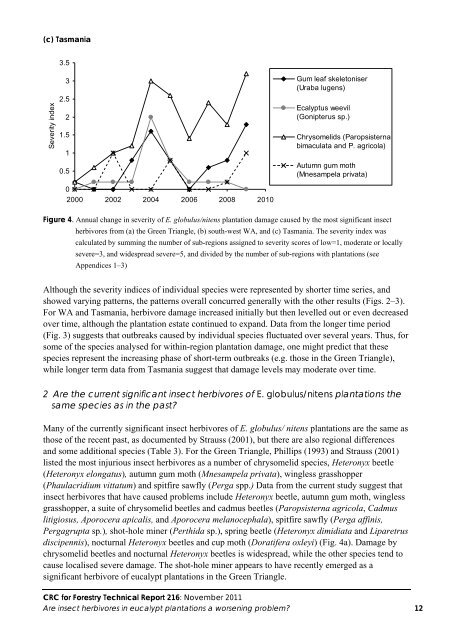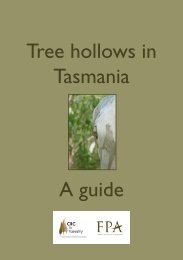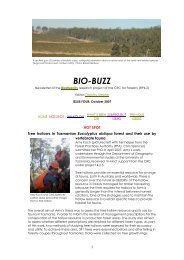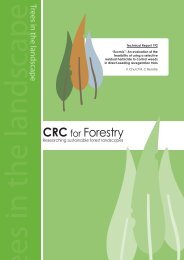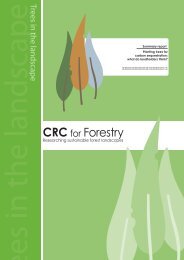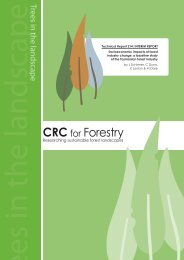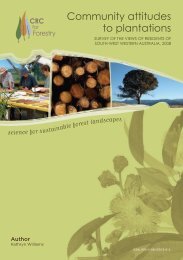CRC Forestry - CRC for Forestry
CRC Forestry - CRC for Forestry
CRC Forestry - CRC for Forestry
You also want an ePaper? Increase the reach of your titles
YUMPU automatically turns print PDFs into web optimized ePapers that Google loves.
(c) Tasmania<br />
Severity index<br />
3.5<br />
3<br />
2.5<br />
2<br />
1.5<br />
1<br />
0.5<br />
0<br />
2000 2002 2004 2006 2008 2010<br />
Gum leaf skeletoniser<br />
(Uraba lugens)<br />
Ecalyptus weevil<br />
(Gonipterus sp.)<br />
Chrysomelids (Paropsisterna<br />
bimaculata and P. agricola)<br />
Autumn gum moth<br />
(Mnesampela privata)<br />
Figure 4. Annual change in severity of E. globulus/nitens plantation damage caused by the most significant insect<br />
herbivores from (a) the Green Triangle, (b) south-west WA, and (c) Tasmania. The severity index was<br />
calculated by summing the number of sub-regions assigned to severity scores of low=1, moderate or locally<br />
severe=3, and widespread severe=5, and divided by the number of sub-regions with plantations (see<br />
Appendices 1–3)<br />
Although the severity indices of individual species were represented by shorter time series, and<br />
showed varying patterns, the patterns overall concurred generally with the other results (Figs. 2–3).<br />
For WA and Tasmania, herbivore damage increased initially but then levelled out or even decreased<br />
over time, although the plantation estate continued to expand. Data from the longer time period<br />
(Fig. 3) suggests that outbreaks caused by individual species fluctuated over several years. Thus, <strong>for</strong><br />
some of the species analysed <strong>for</strong> within-region plantation damage, one might predict that these<br />
species represent the increasing phase of short-term outbreaks (e.g. those in the Green Triangle),<br />
while longer term data from Tasmania suggest that damage levels may moderate over time.<br />
2 Are the current significant insect herbivores of E. globulus/nitens plantations the<br />
same species as in the past?<br />
Many of the currently significant insect herbivores of E. globulus/ nitens plantations are the same as<br />
those of the recent past, as documented by Strauss (2001), but there are also regional differences<br />
and some additional species (Table 3). For the Green Triangle, Phillips (1993) and Strauss (2001)<br />
listed the most injurious insect herbivores as a number of chrysomelid species, Heteronyx beetle<br />
(Heteronyx elongatus), autumn gum moth (Mnesampela privata), wingless grasshopper<br />
(Phaulacridium vittatum) and spitfire sawfly (Perga spp.) Data from the current study suggest that<br />
insect herbivores that have caused problems include Heteronyx beetle, autumn gum moth, wingless<br />
grasshopper, a suite of chrysomelid beetles and cadmus beetles (Paropsisterna agricola, Cadmus<br />
litigiosus, Aporocera apicalis, and Aporocera melanocephala), spitfire sawfly (Perga affinis,<br />
Pergagrupta sp.), shot-hole miner (Perthida sp.), spring beetle (Heteronyx dimidiata and Liparetrus<br />
discipennis), nocturnal Heteronyx beetles and cup moth (Doratifera oxleyi) (Fig. 4a). Damage by<br />
chrysomelid beetles and nocturnal Heteronyx beetles is widespread, while the other species tend to<br />
cause localised severe damage. The shot-hole miner appears to have recently emerged as a<br />
significant herbivore of eucalypt plantations in the Green Triangle.<br />
<strong>CRC</strong> <strong>for</strong> <strong>Forestry</strong> Technical Report 216: November 2011<br />
Are insect herbivores in eucalypt plantations a worsening problem? 12


